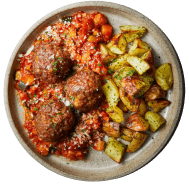
One of our hero ingredients because they contain high-quality protein, fibre, carbohydrates, minerals and play a key role in balanced diets the world over. You’ll find chickpeas in our Chickpea Masala and our Chicken Jalfrezi.
Interesting facts
The chickpea (Cicer arietinum L.), is also known as the garbanzo bean or Bengal gram, is a considered an Old-World pulse as it was one of the early crops we started farming with in the Neolithic era. As a staple food, pulses played a crucial role in ancient diets as they were easy to store thanks to their long shelf life.
Chickpeas originated in an area located between the southeast of Turkey and the western part of the Fertile Crescent (a region in the Middle East also known as the ‘Cradle of Civilization’). The chickpea was domesticated around 7 000 BC and the chickpea we eat today is very different from the wild varieties we started with. It has a thinner peel and a larger seed size and now is grown in over fifty countries across the world.
A source of
- Folic acid
- Iron
- Zinc
- Magnesium
- B vitamins
- Essential amino acids
- Carotenoids
- Fibre
Nutrition
On the nutrition front, chickpeas provide many essential vitamins and minerals we need for good health. They contain several of the B vitamins - riboflavin, niacin, thiamin, folate - and the vitamin A precursor b-carotene.
They are also a good source of Iron, Zinc, and Magnesium.
The chickpea contains good amounts of many essential amino acids (the building blocks of protein) so is a good protein source for the those following vegetarian or vegan diets.
Generally low in fat (obviously how you cook them may change this!) the chickpea does contain some nutritionally important unsaturated fatty acids such as linoleic and oleic Acids (which are considered ‘healthy fats’).
Chickpeas are considered a functional food (or in field doctor language a ‘hero ingredient’) because they provide health benefits beyond basic nutrition. They contain lots of physiologically active components (carotenoids, phytates, phenolic compounds, oligosaccharides, enzyme inhibitors, etc.) which are thought to play a role in potentially lowering the risk of certain chronic diseases.
Key health benefits
Heart health
Chickpeas are a good source of soluble fibre and bioactive compounds (e.g. phytosterols, saponins and oligosaccharides) known to reduce LDL-cholesterol (the bad cholesterol). They also contain isoflavones which are thought to help reduce heart disease through keeping your blood vessels healthy. Chickpeas also contain folic acid which helps in reducing serum homocysteine concentrations, a risk factor for heart disease.
Better blood glucose regulation
Pulses such as chickpea have a higher amount of resistant starch and amylose which slows down the absorption of glucose into your bloodstream.
Cancer
When you eat chickpeas your bacteria produce butyrate (a Short Chain Fatty Acid) thought by killing off any abnormal cells and may reduce the risk of colorectal cancer. Lycopene, present in chickpea seeds, may also reduce the risk of prostate cancer.
Weight loss
Eating foods high in fibre (which chickpeas are) can help you feel fuller for longer. This is due to the slower release of sugar from your meal and this result in an increase in cholecystokinin (a gastrointestinal peptide and hunger suppressant) and increased feeling of fullness.
Keeps you regular
Increased fibre (chickpeas contain lots of dietary fibre) is linked with a faster transit time through your gut and the end result is an easier, more pleasurable trip to the toilet.
What about anti-nutrients?
Legumes such as chickpeas sometimes get a bad name because of something called anti-nutrients. Anti-nutrients can block the absorption of nutrients in your gut and are substances that naturally occur in plant and animal foods. Phytates, saponins and tannins are examples of antinutrients found in chickpeas. Phytic acid can bind to Fe, Zn, Ca and Mg and inhibit absorption, tannins (that give chickpeas the slight bitter taste) can inhibit digestive enzymes and saponins also give a bitter taste.
However, anti-nutrients are not as bad as their name implies. They are thought to have numerous health benefits. Saponins, common in legumes, can decrease cholesterol, reduce the risk of cancer, and lower your blood glucose. The other anti-nutrients have also been linked with better immune function, support blood glucose regulation and antioxidant properties thought to reduce the risk of cancer and inflammation.
Studies on vegetarians who eat diets high in plant foods containing anti-nutrients do not generally show deficiencies in iron and zinc, so the body may be adapting to the presence of anti-nutrients by increasing the absorption of these minerals in the gut.
And if you are still not convinced you like the aide of anti-nutrients in your food, they can be reduced or eliminated by soaking before, cooking, and boiling chickpeas. You can also pair chickpeas with foods high in vitamin C (e.g. we use red pepper) to increase the availability of iron and zinc.
If you are on the Low FODMAP diet.
If you are avoiding FODMAPs you can still have up to 42g of canned chickpeas (1/4 cup). Ensure you pour off the canned water (this contains the FODMAPs) and you can also rinse your canned chickpeas with little water for extra peace of mind.
They are fantastic added to salads and soups.



















